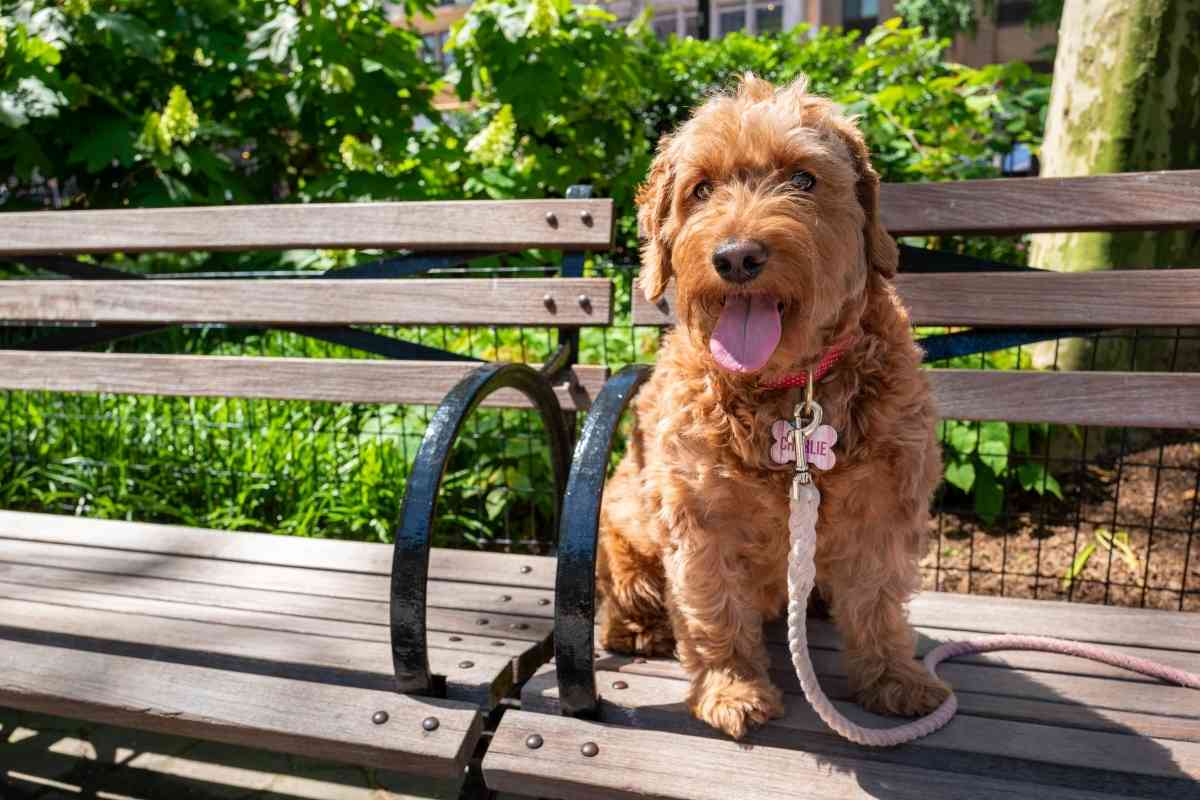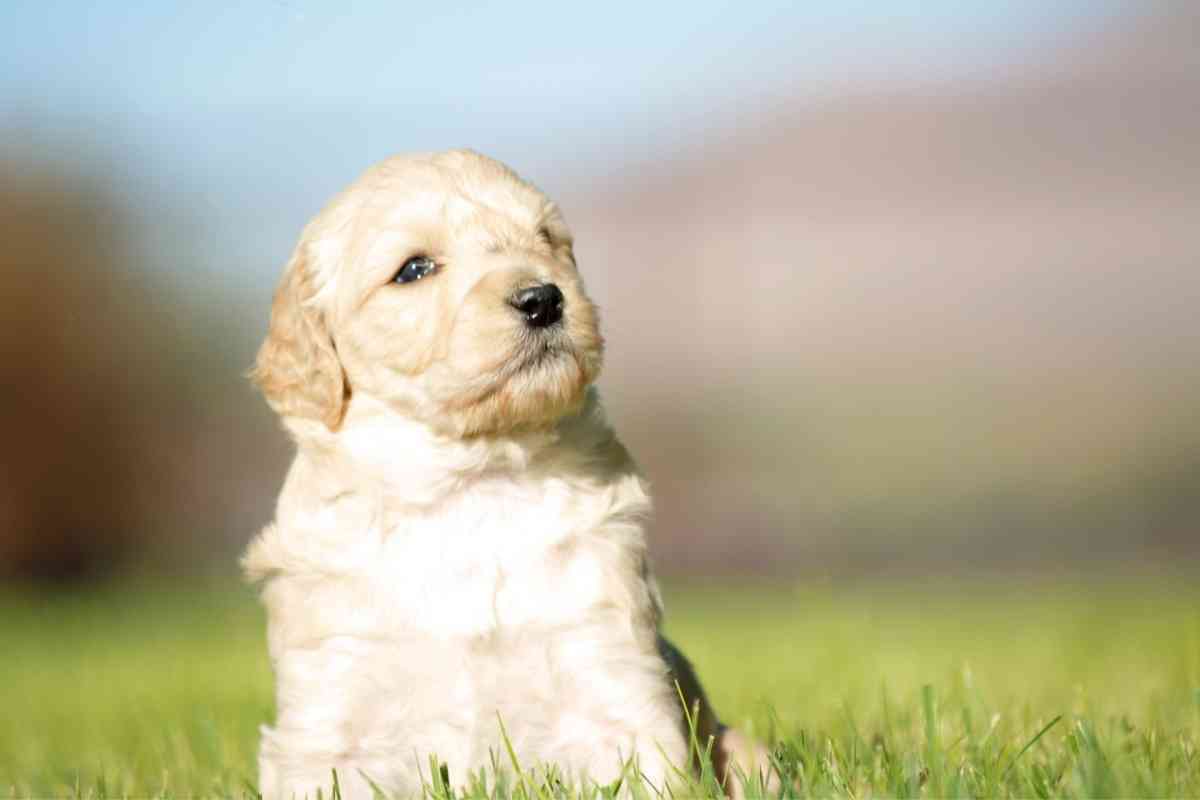Should I get an F1 or F1B Goldendoodle?
Goldendoodles have become a favorite breed to buy and adopt. They have amazing personalities and love to play, cuddle, and show their owners lots of affection.
When shopping around for a Goldendoodle, you might hear the terms “F1” and “F1B puppies.”
What does that mean? Is one type of Goldendoodle better than another?
I researched the differences between an F1 Goldendoodle and an F1B Goldendoodle and found the following information.
Should I get an F1 or F1B Goldendoodle?
If you have allergies to dogs or pet dander, getting an F1B Goldendoodle is a better choice because they don’t shed. They are 75% Poodle, so their fur is more similar to that breed, which does not shed.
What Is an F1 Goldendoodle?
An F1 Goldendoodle puppy is bred from a purebred Golden Retriever and a Poodle. The “f” stands for filial, and the number is the generation of the offspring.
These puppies have 50% of the genetics from each of these dogs.

There may be varying degrees of shedding from this set of offspring, depending on which coat it inherits.
If it has a straighter coat, like a Golden Retriever’s, they will shed more.
Those with wavy or curly will either shed very little or not at all.
Dogs with coats more similar to the Poodle need more routine grooming, however.
One will not know the exact coat of their Goldendoodle until they are around a year old.
Potential owners who have allergies may not want to get an F1 dog because of this. F1B puppies might be more attractive in that regard.
What Is an F1B Goldendoodle?
F1B Goldendoodles are puppies with one parent that is 100% Poodle or Golden Retriever, and the other is an F1.
The “B” refers to the backcross breeding for a mixed doodle with a purebred dog. The purebred dog is usually a Poodle because breeders will want their litters to have the hypoallergenic quality.
Both sets of offspring will have excellent temperaments. The puppies will have the loving and energetic personalities of both parents. In that regard, one generation is not better than the other.
Size Comparisons
F1 and F1B Goldendoodles are also bred with Standard and Miniature Poodles so breeders can offer different sizes: Standard doodles are about 50-80lbs., Medium doodles are between 20-30lbs., and Miniature doodles are 7-10 lbs.
Potential Goldendoodle owners can choose which size dog they want that complements their lifestyle best.

The Standard and Medium Goldendoodles will have the same personalities and temperaments as their parents, but the Mini may have some qualities that are different.
While the larger dogs are energetic and can play or be physical for long periods of time, the Toy doodles might not have the stamina for long walks or hikes and be a little more fragile when playing with children in their families.
Miniature doodles might demand more attention since their lineage includes miniature Poodles, which were bred to be lap dogs for French aristocrats in the 18th century.
They may be more prone to separation anxiety because of this. Medium and Standard Goldendoodles tend to be more independent and laid-back.
Genetic Health Risks
F1 Goldendoodles have less risk of inheriting genetic disorders from their parents because they are direct offspring from purebred Golden Retrievers and Poodles.
F1B doodles, however, pose more of a risk of having one. Disorders can be detected through testing at the vet.
Responsible breeders make sure to get the parent dogs tested and do not breed those who test positive for the genes to these illnesses.
Both Golden Retrievers and Poodles are at risk to develop certain diseases and health issues.
Some of these are hip and elbow dysplasia, dilated cardiomyopathy, and progressive retinal atrophy (which is more common in the Poodle breed).
Hip and elbow dysplasia are abnormal skeletal development in the hip and elbow joints.
In hip dysplasia, the socket in the hip joint is not large enough and causes the femur bone to pop out of place and rub against the pelvis. This causes pain and mobility issues.
Malnutrition and obesity can worsen these ailments.
Dilated Cardiomyopathy is a disease where the heart is enlarged and does not circulate blood properly.
This can lead to heart failure and is caused by genetics and or inadequate nutrition.
Progressive retinal atrophy is the deterioration of the retina in the eye. It leads to impaired vision and or complete blindness.
This is a genetic condition that affects many breeds, not just the Poodle.
As said before, good breeders will have gotten the dogs they breed tested for these and other illnesses.
Don’t be afraid to ask these questions and for documentation of the lineage for the puppy that you want to buy. Be sure to take your pup to the vet once you get it to ensure that it is healthy.
Regular vet visits and proper care throughout the dog’s life are important, too. Make sure to give them adequate exercise and high-quality dog food, whether it is kibble or human-grade, that is appropriate for their age and breed size.
Grooming Routines
We talked a little bit about coat differences in the F1 and F1B generations. Going back to that, F1 dogs will have a variety of coat types, ranging from curly like the Poodle’s to straight like the Golden Retrievers’.
F1Bs are most normally bred with a purebred Poodle, resulting in curly, hypoallergenic coats.
Owners may sneeze less with the F1B, but they will also make more frequent trips to the groomer.
Even though they don’t shed, an F1B Goldendoodle still has an undercoat that tangles with the topcoat.
These can lead to mats, which are hazardous to the pup’s health. Mats are hard pieces of tangled fur stuck with dirt and moisture.
They can get tight and heavy, making the dog’s movement difficult and painful.
Mats can cause body odor, skin abrasions, and infections, as well as harbor parasites like fleas and ticks underneath them where topical treatments can’t reach.
Illnesses like Lyme disease can be contracted from these parasites, too.
To prevent the dog’s fur from matting, a well-established grooming routine, both at home and with a professional, is of paramount importance.
F1B dogs will need to be brushed daily and be taken to the groomer every 6-8 weeks.
A short haircut can make grooming a little easier, especially in the hot summer months. Investing in a high-quality electric razor is a good move, too.
Potential owners should weigh in the cost and time they would need to spend on proper grooming for their Goldendoodle before purchasing or adopting a puppy.
This aspect is crucial to their overall health and happiness, so corners can’t be cut when it comes to grooming!
What colors do F1 and F1b Goldendoodles come in?
Both F1 and F1B Goldendoodle puppies can be born in a variety of coat colors. The color of the dog’s coat is dependent on its ancestry.
These colors are usually black, white, brown, red, and an apricot or honey shade. Some may be born with a mixture like merle, brindle, sable, and phantom.
Now that you have all the information in F1 and F1B Goldendoodles, good luck finding the new addition to your home!